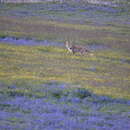fi
nimet breadcrumb-navigoinnissa


Short yips are passed between animals to communicate, but since the pairs usually stay together, no long distance communication is known or thought necessary. Scent is used to define territory, but the foxes are not known to actively defend their area.
Communication Channels: visual ; tactile ; acoustic ; chemical
Other Communication Modes: scent marks
Perception Channels: visual ; tactile ; acoustic ; chemical
V. ferrilata was formerly (1996) on the IUCN Redlist as a species of Lower Risk (least concern), but is currently unlisted.
US Migratory Bird Act: no special status
US Federal List: no special status
CITES: no special status
IUCN Red List of Threatened Species: least concern
Kits do not emerge from the den for some weeks after their birth, but quickly develop, and within 8-10 months are sexually mature. (Schaller, 2000)
These animals apparently have no negative impact on humans.
The only known predators of this species are humans, who commonly trap and kill V. ferrilata for their fur. There is a large industry in the higher areas of Tibet and Nepal for the fox’s fur, which is usually made into hats. The fur is prized for this, because of its great ability to protect its wearer from the wind and other elements.
Positive Impacts: body parts are source of valuable material
Tibetan sand foxes play a significant role in controlling the rodent and small animal population. They may also help to aerate the soil by digging their dens.
Ecosystem Impact: soil aeration
Foxes hunt in pairs (one male, one female) and will share whatever food is caught. They eat mostly rodents, hares, rabbits, and small ground birds. However, anything that can be caught will be eaten. The Black lipped pika, also sharing the same range and habitat, seems to be a preferred prey item.
Animal Foods: birds; mammals; eggs
Primary Diet: carnivore (Eats terrestrial vertebrates)
Tibetan foxes have been known to inhabit the Tibetan plateau of India, China, Sutlej valley of northwestern India and parts of Nepal, specifically the Mustang district.
Biogeographic Regions: palearctic (Native ); oriental (Native )
Tibetan sand foxes have been reported to inhabit barren slopes and streambeds. They appear to prefer rocky or brushy areas at high elevation. They are found on the Tibetan Steppe at a maximum altitude of 5.300 m. These animals live in excavated dens or burrows under rocks or in crevices of boulder piles.
Range elevation: 5300 (high) m.
Habitat Regions: temperate ; terrestrial
Terrestrial Biomes: chaparral ; scrub forest ; mountains
Some researchers assume a lifespan of 8-10 years under ideal circumstances. Most foxes are lost to natural causes or human trackers before their fifth year.
Range lifespan
Status: wild: 8 to 10 years.
Typical lifespan
Status: wild: 5 (high) years.
Tibetan sand foxes range in color from black, to brown and rusty-colored, to yellowish on neck and back. They possess a tawny band on the dorsal region and white on the tail, muzzle and belly. The fur is thick, with a dense undercoat.
From nose to tail, The head and body length of Vulpes ferrilata measures from 575 to 700 mm. The tail adds an additional 400 to 475 mm to the total length. These animals weigh between 3 and 4 kg. There is no information available on sexual differences in size. The muzzle is elongated relative to most fox species. The teeth are well developed with extraordinarily long canines and narrow maxilla.
Range mass: 3 to 4 kg.
Range length: 975 to 1175 mm.
Other Physical Features: endothermic ; bilateral symmetry
When threatened, Tibetan sand foxes retreat to their dens.
Known Predators:
V. ferrilata is apparently monogamous, with mated pairs staying together for life.
Mating System: monogamous
Mating season falls around late February to early March, and pairs of foxes stay together and are life-long mates. They live, hunt and share the responsibility of raising the young together. The gestation period is thought to be 50 to 60 days. Kits are born in late April to early May. The litter size ranges from 2 - 5 kits. The kits do not emerge from the den for some weeks after birth, so the exact gestation period is unknown.
Breeding interval: It seems these animals breed once annually.
Breeding season: Breeding occurs in late February or early March.
Range number of offspring: 2 to 5.
Range gestation period: 50 to 60 days.
Key Reproductive Features: iteroparous ; seasonal breeding ; gonochoric/gonochoristic/dioecious (sexes separate); sexual ; fertilization ; viviparous
All canid young are altricial. V. ferrilata young o not emerge from their natal dens until they are several weeks old. The exact timing of weaning has not been reported. Because the species is monogamous, both parents are involved in caring for the young.
Parental Investment: no parental involvement; altricial ; pre-fertilization (Protecting: Female); pre-hatching/birth (Provisioning: Female, Protecting: Male, Female); pre-weaning/fledging (Provisioning: Female, Protecting: Male, Female); pre-independence (Provisioning: Male, Female, Protecting: Male, Female); extended period of juvenile learning